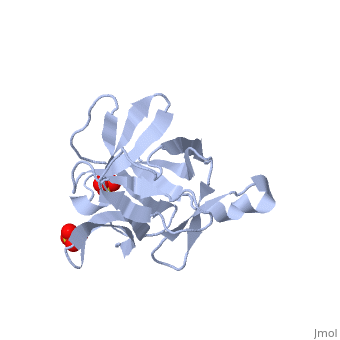2nvh
From Proteopedia
Determination of Solvent Content in Cavities in Interleukin-1 Using Experimentally-Phased Electron Density
Structural highlights
FunctionIL1B_HUMAN Produced by activated macrophages, IL-1 stimulates thymocyte proliferation by inducing IL-2 release, B-cell maturation and proliferation, and fibroblast growth factor activity. IL-1 proteins are involved in the inflammatory response, being identified as endogenous pyrogens, and are reported to stimulate the release of prostaglandin and collagenase from synovial cells.[1] Evolutionary ConservationCheck, as determined by ConSurfDB. You may read the explanation of the method and the full data available from ConSurf. Publication Abstract from PubMedThe extent to which water is present within apolar cavities in proteins remains unclear. In the case of interleukin-1beta (IL-1beta), four independent structures solved by x-ray crystallography indicate that water is not present in the central apolar cavity. In contrast, results from NMR spectroscopy suggest that water has high occupancy within the cavity but is positionally disordered, making it undetectable by standard crystallographic methods. A theoretically based crystallographic-phase refinement technique also suggested that there was the equivalent of two fully occupied water molecules within the apolar cavity. To resolve these discrepancies we sought to obtain an experimentally phased electron density map that was free of possible bias caused by mathematical modeling of the protein or the solvent. By combining native diffraction data with multiple wavelength anomalous data from a platinum derivative, accurate phases were obtained. Using these experimental phases, we estimate that occupancy of the apolar cavity in IL-1beta by solvent is close or equal to zero. Polar cavities in the protein that contain ordered solvent molecules serve as internal controls. Determination of solvent content in cavities in IL-1beta using experimentally phased electron density.,Quillin ML, Wingfield PT, Matthews BW Proc Natl Acad Sci U S A. 2006 Dec 26;103(52):19749-53. Epub 2006 Dec 18. PMID:17179045[2] From MEDLINE®/PubMed®, a database of the U.S. National Library of Medicine. See AlsoReferences
| ||||||||||||||||||||


